proposal of public realm and urban landscape for Piazza della Scala
location: Milan, Italy
year: 2015
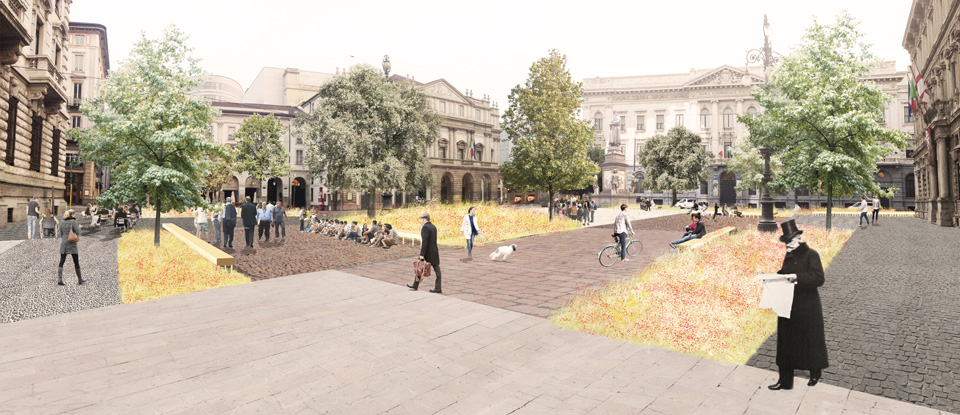
Piazza della Scala is one the most popular and representative Milan’s public areas. Besides a touristic attraction, the Piazza is a meeting-point, a civic place where outdoors cultural activities are very common all year round. It is, in a wider sense, an important focus of Milan’s cultural life, particularly thanks to the building named after the Piazza and situated at its northwest side: the Teatro alla Scala -La Scala Opera House-, one of the world’s most famous opera houses, designed by Giuseppe Piermarini in 1778.
Before the mid-19th century, the area was still occupied by several buildings. Following their demolition, the new open square at the foot of the Teatro was definitely created. Soon later, new buildings were built up along the Piazza’s boundary to enrich the perceptive values of that public space: the Galleria Vittorio Emanuele II, built from 1865 to 1878 by Giuseppe Mengoni, is a commercial street covered by vaults and arcs of iron and glass, designed to connect Piazza Duomo to the new Piazza alla Scala. Today, it is one of the world’s oldest shopping malls. On the Piazza’s southeast side, Luca Beltrami designs in 1892 the new facade of the mid-16th century Galeazzo Alessi’s Palazzo Marino, which had been Milan’s town hall since 1861. After the previous buildings were pulled down, the Palazzo’s northwest facade seemed disproportionate and in complete disharmony to the new neoclassic image desired for the Piazza. In order to solve this, Beltrami based his design on the southeast facade of the Alessi’s original project, the one which today still looks to Piazza San Fedele. The neoclassic facades of those two new buildings did away with the old character of the Piazza, and created a new common identity, which will be shared with the last buildings to be built up on the site: the Banca Commerciale Italiana, designed in 1906 by Beltrami; and the Palazzo della Civica Ragioneria, built between 1918 and 1927, also a Beltrami’s design.
Meanwhile, a statue of granite and marble of Leonardo da Vinci, a Pietro Magni’s work, was placed at the Piazza’s centre in 1872. The monument was not centred by chance on the visual axis between the Teatro alla Scala and the Palazzo Marino. For the new bourgeoisie of Milan, Leonardo symbolised the union of culture and politics, which the Italia born after the 19th century Unification aspired to. In addition to Leonardo’s monument, Beltrami also designed the street furniture, the flower beds, the fountain and the streetlights around the monument which decorate the Piazza. Bearing all of this in mind, we may well owe to Beltrami one of the most recognised public areas in Milan, whose singularity has been kept even after having been adapted to the traffic flows and urban needs during the 20th century.
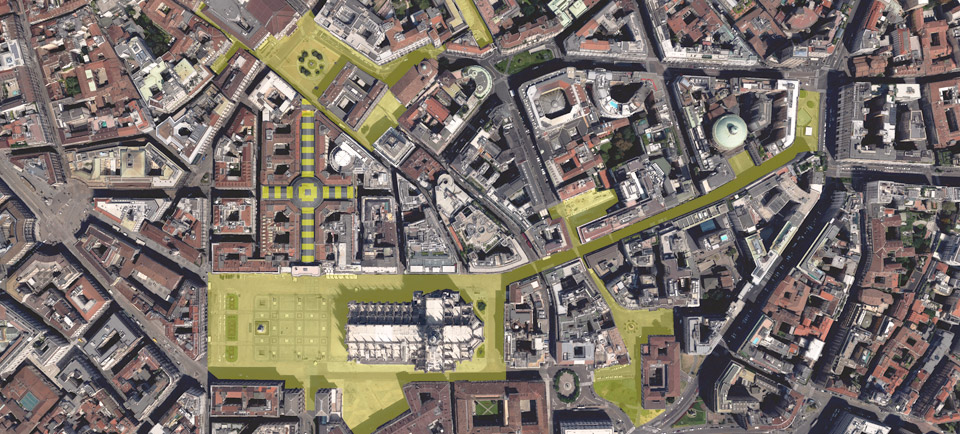
Rather than being a cultural square, the Piazza is also part of the system of pedestrian public areas of Milan city centre, comprising the nearby Piazza San Fedele, Via Filodrammatici and Piazza Duomo through the Galleria Vittorio Emanuele II. Altogether, they add up to around 70.000 m2 of pedestrianized areas. In our opinion, any intervention on this space must follow two guidelines: the upholding of the public cultural use and the strengthening of the pedestrian system.
Urban space quality objectives
In order to strengthen the civic and cultural uses at the Piazza we propose an array of quality objectives -or guidelines for the refurbishment of the area from a neighbourhood scale. For us, the Piazza is not only the area around the Teatro alla Scala, but a more extensive public space integrated into the urban fabric of Milan’s city centre, with a special relationship with Piazza Duomo. Thus, our proposal of quality objectives has to be read as a strategy for intervention: they point out the most valuable Piazza’s strengths and qualities to express the aspirations of a global image for the Piazza and its environment.
In order to strengthen the civic and cultural uses at the Piazza we propose an array of quality objectives -or guidelines for the refurbishment of the area from a neighbourhood scale. For us, the Piazza is not only the area around the Teatro alla Scala, but a more extensive public space integrated into the urban fabric of Milan’s city centre, with a special relationship with Piazza Duomo. Thus, our proposal of quality objectives has to be read as a strategy for intervention: they point out the most valuable Piazza’s strengths and qualities to express the aspirations of a global image for the Piazza and its environment.
We propose:
-identifying the architectural values of both the Piazza and its buildings. As a direct result of the aesthetically homogeneous process of Milan’s urban development in the 19th century, they are inseparable from Milan’s identity and need to be public for citizens and tourists.
-improving the quality of the urban scenery with new materials, vegetation and street furniture, used in a respectful manner towards the Piazza’s architectural values. They must help to make the public space more charming and attractive, an open and accessible urban square which can be freely enjoyed by the neighbours regardless of their age or physical condition.
-integrating in a more effective way the Piazza into the pedestrian areas of Milan’s city centre, while the diversity of uses is fostered in the public realm.
-facilitating the public and accessible uses in the Piazza as a prolongation of the surrounding cultural spaces, museums and theatres, as a natural prolongation of the culture into the public realm.
-favouring the civic use of the urban space by turning the Piazza into a place where people can meet, take a seat, talk, rest or play.
-prioritizing the pedestrian areas and the sustainable urban mobility instead of the traffic flows into the Piazza’s urban fabric. We propose actions to calm down the traffic, to promote the use of bicycles and to give priority to pedestrians and not to cars.
-identifying the architectural values of both the Piazza and its buildings. As a direct result of the aesthetically homogeneous process of Milan’s urban development in the 19th century, they are inseparable from Milan’s identity and need to be public for citizens and tourists.
-improving the quality of the urban scenery with new materials, vegetation and street furniture, used in a respectful manner towards the Piazza’s architectural values. They must help to make the public space more charming and attractive, an open and accessible urban square which can be freely enjoyed by the neighbours regardless of their age or physical condition.
-integrating in a more effective way the Piazza into the pedestrian areas of Milan’s city centre, while the diversity of uses is fostered in the public realm.
-facilitating the public and accessible uses in the Piazza as a prolongation of the surrounding cultural spaces, museums and theatres, as a natural prolongation of the culture into the public realm.
-favouring the civic use of the urban space by turning the Piazza into a place where people can meet, take a seat, talk, rest or play.
-prioritizing the pedestrian areas and the sustainable urban mobility instead of the traffic flows into the Piazza’s urban fabric. We propose actions to calm down the traffic, to promote the use of bicycles and to give priority to pedestrians and not to cars.
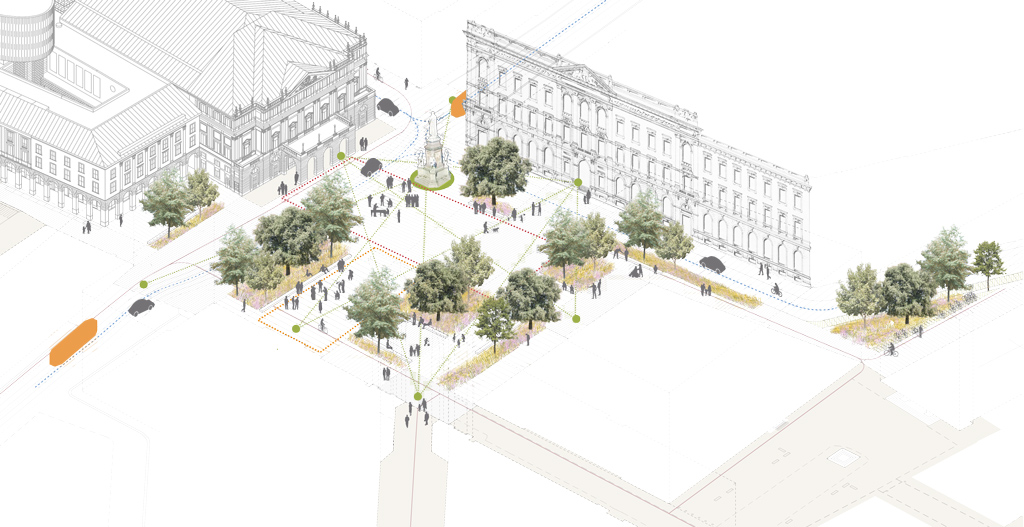
Urban landscape strategy
Thoroughly integrated into our proposal as landscape quality objectives, site analysis and citizens’ aspirations are developed in these four strategies:
Thoroughly integrated into our proposal as landscape quality objectives, site analysis and citizens’ aspirations are developed in these four strategies:
Strategy 1: New position of the monument to Leonardo da Vinci opposite the Teatro alla Scala.
Centred at the Piazza, the monument attracts most of citizens and tourists’ attentions, but it accidentally overlaps and hides the buildings’ facades which wrap the Piazza. When it is moved from the centre to the northern side of the Piazza, opposite the Teatro, new views are released, facades show up and the monument to Leonardo turns into an urban landmark, now visible from the nearby streets. Owing to this, the monument’s position is an essential element of the city centre fabric.
Centred at the Piazza, the monument attracts most of citizens and tourists’ attentions, but it accidentally overlaps and hides the buildings’ facades which wrap the Piazza. When it is moved from the centre to the northern side of the Piazza, opposite the Teatro, new views are released, facades show up and the monument to Leonardo turns into an urban landmark, now visible from the nearby streets. Owing to this, the monument’s position is an essential element of the city centre fabric.
Strategy 2: Inner views in the Piazza.
The new views reinforce the character of the Piazza as a foyer, as a prolongation of the cultural activity of both the Teatro and museums into the Piazza. The goal is to make heritage on view at once. Thereby, the Piazza can be understood from the specific to the generic, as a true urban scenery where life is celebrated among history and heritage.
The new views reinforce the character of the Piazza as a foyer, as a prolongation of the cultural activity of both the Teatro and museums into the Piazza. The goal is to make heritage on view at once. Thereby, the Piazza can be understood from the specific to the generic, as a true urban scenery where life is celebrated among history and heritage.
Strategy 3: Vegetation.
To balance the weight of cultural uses, civic uses and heritage in the Piazza, we use the vegetation. Places are more attractive when they are given the possibility to be simultaneously used in different ways. Thus, nine small green areas with trees and flowers are delimited in the Piazza, oriented without restricting the outlook of facades and monuments. The green areas offer different levels of privacy, are protected from the traffic noise and host cultural activities. Each green area has a longitudinal bench, shadowed by the trees in the summertime, which help people meet: if two benches are on opposite sides spontaneous talks will bring off. It is a useful tool for building a city’s identity.
To balance the weight of cultural uses, civic uses and heritage in the Piazza, we use the vegetation. Places are more attractive when they are given the possibility to be simultaneously used in different ways. Thus, nine small green areas with trees and flowers are delimited in the Piazza, oriented without restricting the outlook of facades and monuments. The green areas offer different levels of privacy, are protected from the traffic noise and host cultural activities. Each green area has a longitudinal bench, shadowed by the trees in the summertime, which help people meet: if two benches are on opposite sides spontaneous talks will bring off. It is a useful tool for building a city’s identity.
Strategy 4: Pedestrian priority area.
The Piazza is a tourist hub, but also an urban node in which people coming from Via Verdi, Via Manzoni and Via Filodrammatici come across those coming from the Duomo and the Galleria Vittorio Emanuele II. Because of the traffic on Via Manzoni, Via Verdi and Via Case Rotte, priority at the crossings is given to the cars, and people have to wait long for their turn. What is more, the pavements are not wide enough for the numerous people which arrive at the Piazza at peak times or during the summer and, as a consequence, the current layout is quite uncomfortable for pedestrians. To make the most of the Piazza as a meeting point, pedestrians need to be given back the priority. Early 20th century pictures and paintings show the Piazza as a shared space for pedestrians, horse carriages and trams. Even if it is not easy to bring that freedom back -because today’s number of cars is much bigger-, it is still possible to turn the Piazza into a pedestrian priority area accessible without curbs, connected to other nearby pedestrian areas, and with different paving materials to warn drivers to reduce the speed while driving through the Piazza. Thus, zebra crossings are removed, the number and width of traffic lanes are decreased in Via Case Rotte, and some turns are restricted in Via Manzoni.
The Piazza is a tourist hub, but also an urban node in which people coming from Via Verdi, Via Manzoni and Via Filodrammatici come across those coming from the Duomo and the Galleria Vittorio Emanuele II. Because of the traffic on Via Manzoni, Via Verdi and Via Case Rotte, priority at the crossings is given to the cars, and people have to wait long for their turn. What is more, the pavements are not wide enough for the numerous people which arrive at the Piazza at peak times or during the summer and, as a consequence, the current layout is quite uncomfortable for pedestrians. To make the most of the Piazza as a meeting point, pedestrians need to be given back the priority. Early 20th century pictures and paintings show the Piazza as a shared space for pedestrians, horse carriages and trams. Even if it is not easy to bring that freedom back -because today’s number of cars is much bigger-, it is still possible to turn the Piazza into a pedestrian priority area accessible without curbs, connected to other nearby pedestrian areas, and with different paving materials to warn drivers to reduce the speed while driving through the Piazza. Thus, zebra crossings are removed, the number and width of traffic lanes are decreased in Via Case Rotte, and some turns are restricted in Via Manzoni.
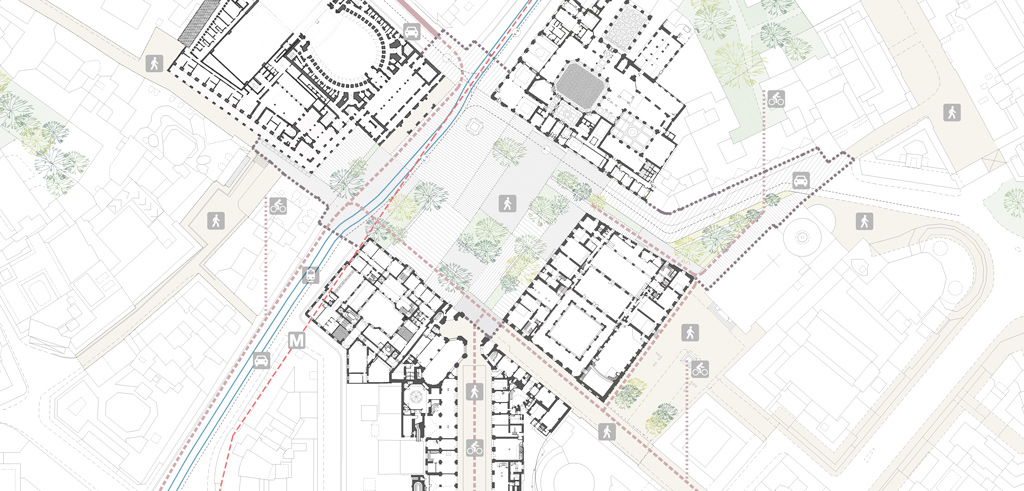
Planning and project proposal
Concerning the public use of the Piazza, one of the main objectives of our proposal is to reclaim the urban space which is now occupied by traffic lanes at Via Case Rotte, Largo Raffaele Mattioli and Via Manzoni. Once added them to the Piazza, the pedestrian area will reach to the foot of both the Teatro alla Scala and the Banca Commerciale Italiana. Bearing in mind the aim of sustainable mobility, the new Piazza becomes part of Milan’s cyclist network, fostering new pedestrian and cyclist itineraries from the cycle lane which runs along Via Verdi, just beside the Teatro. Cyclists are welcome in the Piazza, where they can freely drive on to continue their way to Piazza San Fedele or Via Verdi. The reclaimed area at Largo Raffaele Mattioli -at present, a motorcycle parking space- is expected to turn into a green area and a bicycle parking space.
Concerning the public use of the Piazza, one of the main objectives of our proposal is to reclaim the urban space which is now occupied by traffic lanes at Via Case Rotte, Largo Raffaele Mattioli and Via Manzoni. Once added them to the Piazza, the pedestrian area will reach to the foot of both the Teatro alla Scala and the Banca Commerciale Italiana. Bearing in mind the aim of sustainable mobility, the new Piazza becomes part of Milan’s cyclist network, fostering new pedestrian and cyclist itineraries from the cycle lane which runs along Via Verdi, just beside the Teatro. Cyclists are welcome in the Piazza, where they can freely drive on to continue their way to Piazza San Fedele or Via Verdi. The reclaimed area at Largo Raffaele Mattioli -at present, a motorcycle parking space- is expected to turn into a green area and a bicycle parking space.
After its last renovation in 1999, the Piazza has an accentuated pedestrian character due to the pedestrian-only itineraries which join it with the Piazza Duomo and Milan’s city centre. Our proposal strengthens this character. As a consequence, the new Piazza is integrated into the pedestrian area of Piazza San Fedele, Via Filodrammatici and Galleria Vittorio Emanuele, as a part of the pedestrian-only Milan’s city centre where all kinds of automobile traffic may be prohibited. At the crossings of the Piazza and its adjacent vehicular traffic streets, pedestrians are given the priority of use: there are no curbs or steps, and the pavement keeps a constant and slightly rising finishing level over the traffic streets, so cars, buses and trams need to stop and reduce their speed to cross those sloped-crossings while entering the Piazza. Thus, the new pavement helps to calm down the traffic and warns drivers pedestrians can walk across the Piazza without restrictions. Keeping this in mind, we will succeed in transforming the Piazza into a safe, handy, friendly and accessible urban square which can be enjoyed by all the citizens and tourists, regardless of their age or physical condition.
However, the civic use is probably the most important part of our proposal. Focusing our attention on the culture and the public use, the new green areas which carpet the Piazza are open to cultural uses, but also to resting, playing and meeting activities, without blocking the views over the heritage of the Piazza. Wrapped by the green areas, other inner smaller areas, characterized by cross-hatching designs, are also ready to welcome those cultural, artistic and playing activities. Like a canvas where spontaneous creativity and day-to-day cultural activities are drawn.
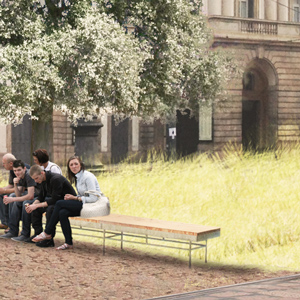
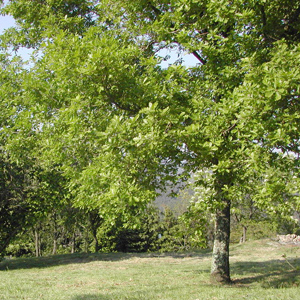
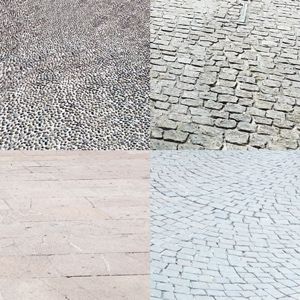
Materialization
Public uses need people’s social interaction: the more diversity of uses there is in the Piazza, the more attractive the place is. The bench helps people meet and talk. It is a simple, longitudinal and prismatic piece, made of stone, stainless steel and wood. It is placed with its back against one of the sides of a green area to create zones with different levels of privacy, which are open but protected from the noise and the traffic: in some situations, two separate benches are placed face-to-face to increase the social interaction; in other situations, the benches are isolated to favour both rest and calmness. In summer, the trees shade and give them shadows and freshness. In winter, instead, they let light in to make it a more comfortable place.
Public uses need people’s social interaction: the more diversity of uses there is in the Piazza, the more attractive the place is. The bench helps people meet and talk. It is a simple, longitudinal and prismatic piece, made of stone, stainless steel and wood. It is placed with its back against one of the sides of a green area to create zones with different levels of privacy, which are open but protected from the noise and the traffic: in some situations, two separate benches are placed face-to-face to increase the social interaction; in other situations, the benches are isolated to favour both rest and calmness. In summer, the trees shade and give them shadows and freshness. In winter, instead, they let light in to make it a more comfortable place.
The vegetation enriches the qualities of the new urban space. As Milan is surrounded by some of the most fertile cultivated lands of the Lombardy plain, we propose using native trees of that fertile lower section of the Po valley, like pedunculate oaks (Quercus robur), holm oaks (Quercus ilex), hornbeams (Carpinus betulus), alders (Alnus glutinosa), field maples (Acer campestre), or ashes (Fraxinus excelsior). All of them are well-adapted to urban environments and to climates characterised by winter frosts and some summer days of extreme hot. The flowerbeds are planted over with some of the aromatic and rustic plants we can find growing in the crop fields around Milan or with some of the bushes which make part of the undergrowth of oaks forests, such as Scilla bifolia, windflower (Anemone nemorosa), woodland strawberry (Fragaria vesca), field poppy (Papaver rhoeas), yarrow (Achillea millefolium), creeping cinquefoil (Potentilla reptans), daisy (Bellis perennis), camomile (Matricaria recutita), common mallow (Malva sylvestris), common chicory (Cichorium intybus), dandelion (Taraxacum officinale), cornflower (Centaurea cyanus), lavender (Lavandula angustifolia), common sage (Salvia officinalis), oregano (Origanum vulgare) or common thyme (Thymus vulgaris). Shapes and colours of the plants will vary according to the rhythm of the seasons.
Milan’s character and its long history are nowadays written in its streets. As centuries passes by, different pavements techniques, such as the ciottolato, the lastricato or the selciato, have been used to pave over Milan’s streets with cobbles of river rock or with prismatic pieces of granite or porphyry. As a result, this has created attractive urban sceneries by contrast of those materials, forms and textures. Bearing in mind this logic of composition, we reintroduce and mix these techniques in the new Piazza to create a heterogeneous pavement, a mosaic floor which reinforces the singular identity of the buildings at La Scala and visually defines the inner areas of the new public realm. We want the Piazza to be respectful with the history and the character of La Scala and Milan.
